
It is difficult for Class A consumers to accurately predict peak hours in advance. This is how to beat the IESO Peak Tracker.
In this five-part series called “Tame the Beast,” the goal is to help you understand:
- Part One: The Different Players in the Ontario Electricity Market
- Part Two: What Happened to Ontario’s Electricity Price
- Part Three: The Impact of Electricity Peaks and What is Global Adjustment
- Part Four: Companies are Trying to Reduce Electricity Costs
- Part Five: How Companies are Reducing Global Adjustment Costs
As outlined in the previous section, it has become increasingly difficult for Class A consumers in the Province of Ontario to accurately predict peak hours in advance by using the IESO Peak Tracker. Given that accurately predicting the peak hours can lead to enormous savings for Class A consumers, many are seeking better solutions.
Read on to find out how some Class A customers have discovered a way to calmly tame the beast, and save up to 70% on their electricity costs.
By maximizing their savings in the ICI Program with highly accurate predictions, some manufacturers have been able to access some of the cheapest electricity available in all of North America. They thereby succeeded in eliminating some of the critical competitive disadvantages that have been inflicted upon them prior.
The publicly available predictions, provided by the IESO via its Peak Tracker, are becoming increasingly inaccurate as they are unable to account for the demand response efforts of other Class A consumers in the market. The simple linear regression spreadsheets employed by some energy consultants are also unable to deal with the enormously complex task of predicting the actions of thousands of Class A consumers.
Without accurate predictions demand response efforts become far too expensive and inefficient.
With thousands of Class A consumers now eligible to participate in the ICI Program, the cumulative effect of their demand response efforts has made most predictive models obsolete.
As most businesses use the same public IESO Peak Tracker as an energy demand data source, their prediction become similar to the Peak Tracker data – which causes concurrent and massive reductions in energy usage. One example of this occurred on September 26th, 2017.
Many businesses were using the publicly available IESO peak tracker data, which predicted that the peak hour would occur between 6 and 7pm. As a result, many businesses reduced their usage at the same time and caused a massive decrease in energy usage. As a result, 7pm did not develop as a peak, and instead peaks occurred the hour before and after the target hour, which created so-called Double Peaks.
Businesses using the public IESO Peak Tracker data missed the real peak when they responded. This creates a major loss to businesses, both due to the lost productivity resulting from shutting down their production in attempts to reduce electricity usage, as well as the lost savings from missing the peak hour.
While savings in the Program usually more than account for the lost production, if a business responds at the wrong time, they still pay for the lost production without saving any money.
In fact, businesses that missed the real peak hour actually incurred even more costs. For example, if ABC Corp. is normally 1% of the Province’s electricity usage, then it would be expected to pay 1% of the Province’s Global Adjustment costs each month as part of being a Class A customer in the ICI Program (this was explained in more detail in section 3).
By opting in to the ICI Program, ABC Corp. was planning to reduce its usage during the peak hours, and therefore only represent 0.5% of the Province’s usage. This would have enabled it to save 50% of its Global Adjustment costs.
However, because it missed the peak hour, while other Class A businesses in the Province did not, ABC Corp.’s proportion of the actual peak usage increased to 1.5%. Not only did ABC Corp. not save money during this peak hour, it had actually increased its costs as it now had to pay more in annual Global Adjustment fees.
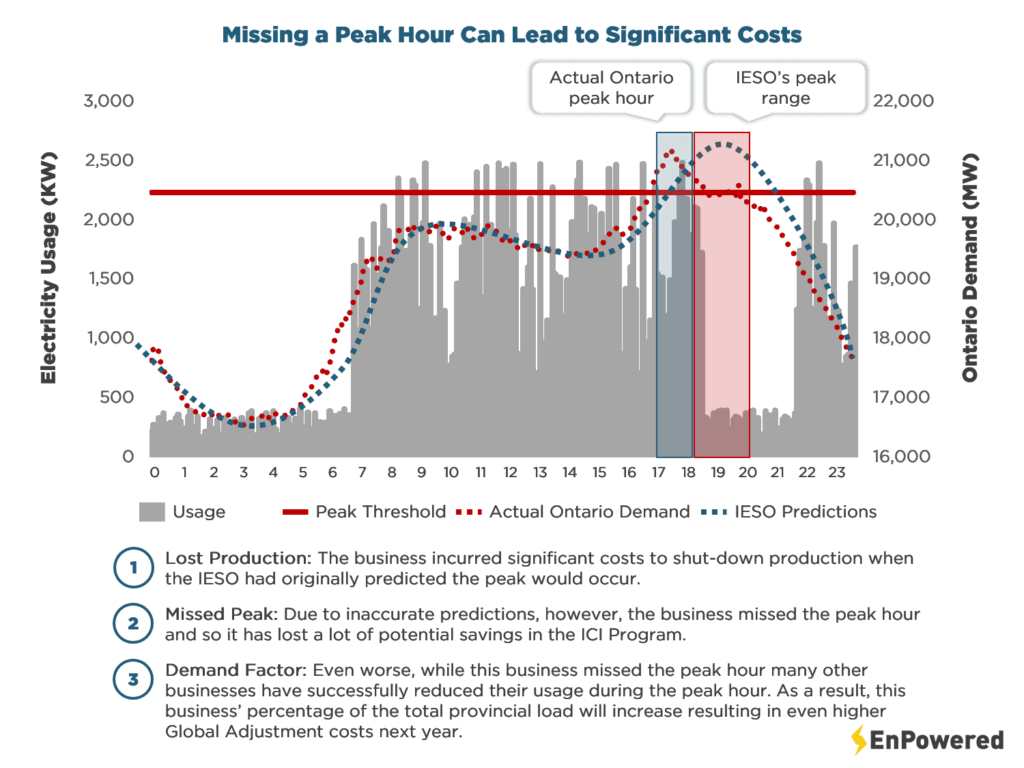
Given this, although the Global Adjustment Class A Program may well look very attractive due to the significant potential savings, those savings are far from being a certain outcome. As an increasing number of businesses participate in the Global Adjustment Class A Program, the challenge of determining true peaks, and differentiating them from false peaks, is a task that grows ever more difficult.
Moreover, the more advance warning an energy consumer has about an upcoming peak, the more they can potentially save during their response. This is achieved by enabling consumers to plan ahead effectively and thereby ensuring that they reduce their usage in a financially efficient manner.
In an effort to help customers manage the ICI Program and maximize their Global Adjustment savings, while minimizing the impact to their production, EnPowered has created a predictive model that is able to address the three primary issues that Class A customers face:
- Advance Warning
- False Peaks
- Peak Hour Precision
Advance Warning
When given advance warning of a potential peak day, a business is able to more effectively organize its demand response efforts and can schedule a plant shutdown, or other initiatives, to maximize their savings in the ICI Program. Some of the creative approaches that EnPowered’s clients have implemented include organizing a maintenance day on a peak day or even hosting a company BBQ.
When a Global Adjustment Class A business has 5-14 days of notice shutdown efforts can be much more cost-effective and efficient. The result is that businesses are able to increase the size of their demand response and minimize impact to their production.
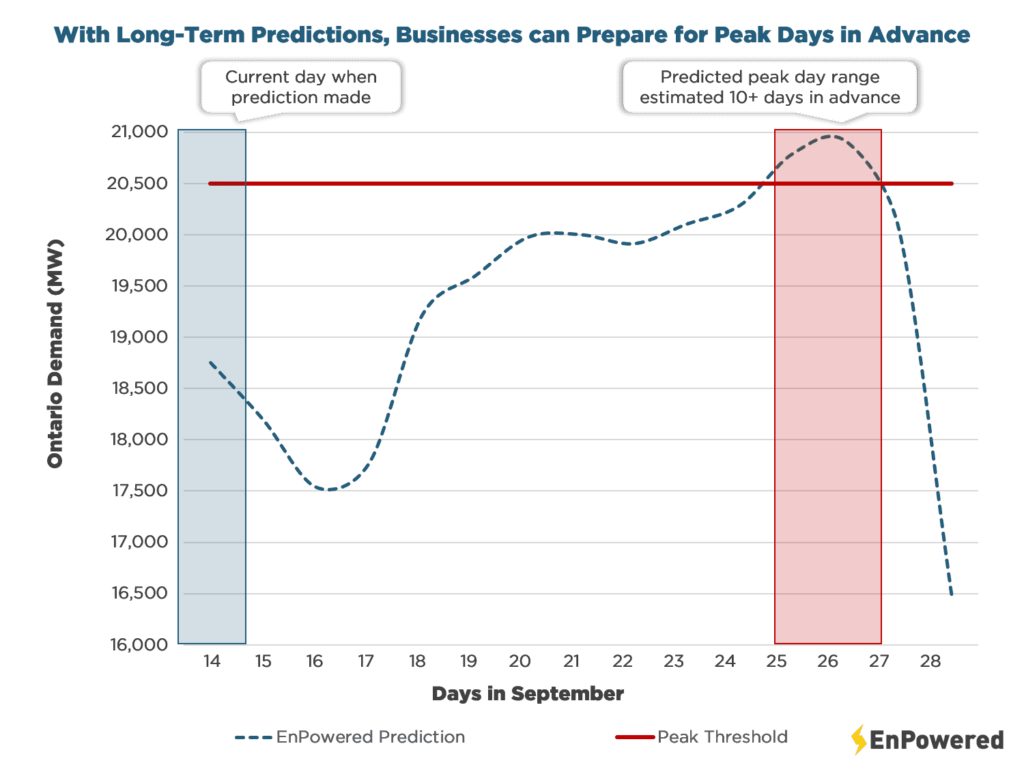
False Peaks
The Ontario energy market, like most commodity markets, can be very difficult to predict without special insider knowledge. With that said, future electricity usage can be forecasted to a certain level of precision, which is a task that the IESO, independent stakeholders, and EnPowered all strive to achieve.
The IESO has an admirable record of 95% accuracy with ± 470 MW, meaning that, on average, its predictions are within 500 MW of actual usage. In contrast, EnPowered has a record of 98.3% accuracy with ± 250 MW.
 | From getting your project funded to finding savings once commissioned, contact us to ease the financial impact of your clean energy transition. Let's talk clean energy solutions. |
The reason EnPowered is much more precise is because we are not only able to predict what the Province’s electricity usage will be under normal circumstances, we are also able to predict how other businesses in the Province will respond during peak hours.
This additional accuracy is extremely valuable to Class A customers as it enables them to avoid False Peak days and thereby reduce their electricity and subsequently Global Adjustment charges.
A False Peak occurs when the publicly available data, provided by the IESO, predicts that a peak will occur, but either due to changing usage patterns or a strong demand response from businesses in the Province, the electricity usage becomes lower than expected and no peak day develops.
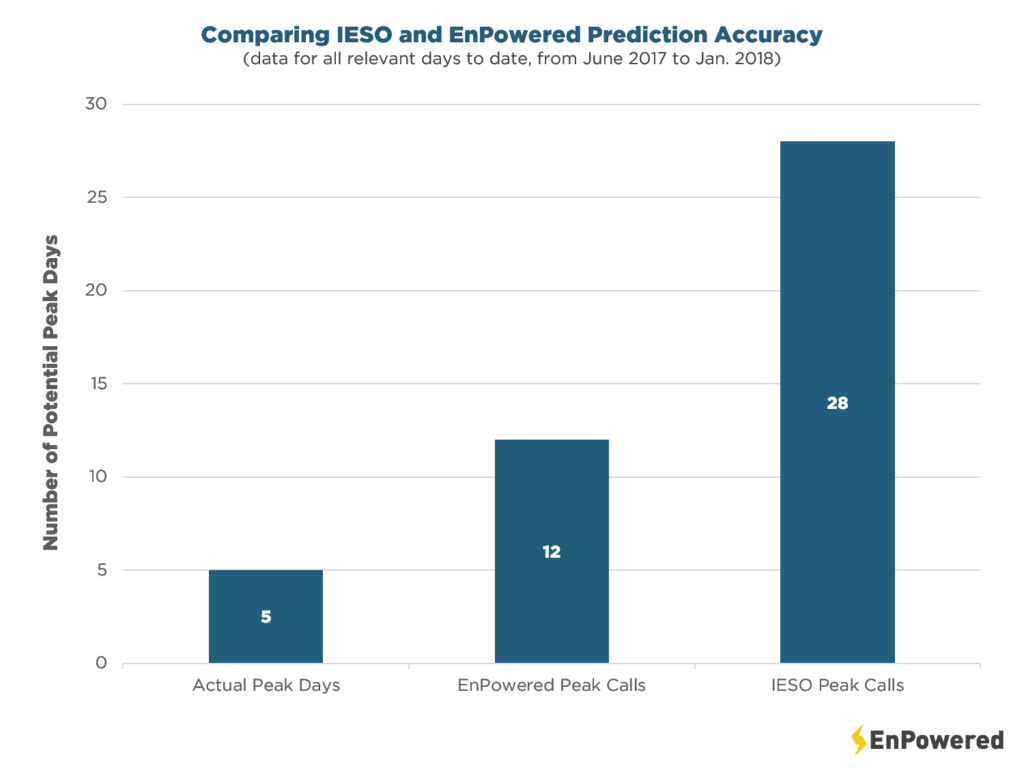
The difference in accuracy of 220 MW may not seem like much. However, that seemingly minute difference means shutting down just ten times instead of thirty-four in a given year, while still catching all five peaks. This translates to significant economic savings, especially when one considers how much just one shutdown costs for a large business.
A False Peak day can lead to significant costs to a Class A customer. If a business responds to a False Peak, they lose a significant amount of productivity with no benefit whatsoever. If a Class A customer is relying on inaccurate predictions, such as those provided by the IESO, they will shut down more frequently in efforts to catch all five peaks, leading to lower savings each year.
In general, EnPowered recommends that Class A customers should only expect to respond to peak hours 10 times each year, and certainly no more than 20 times each year.
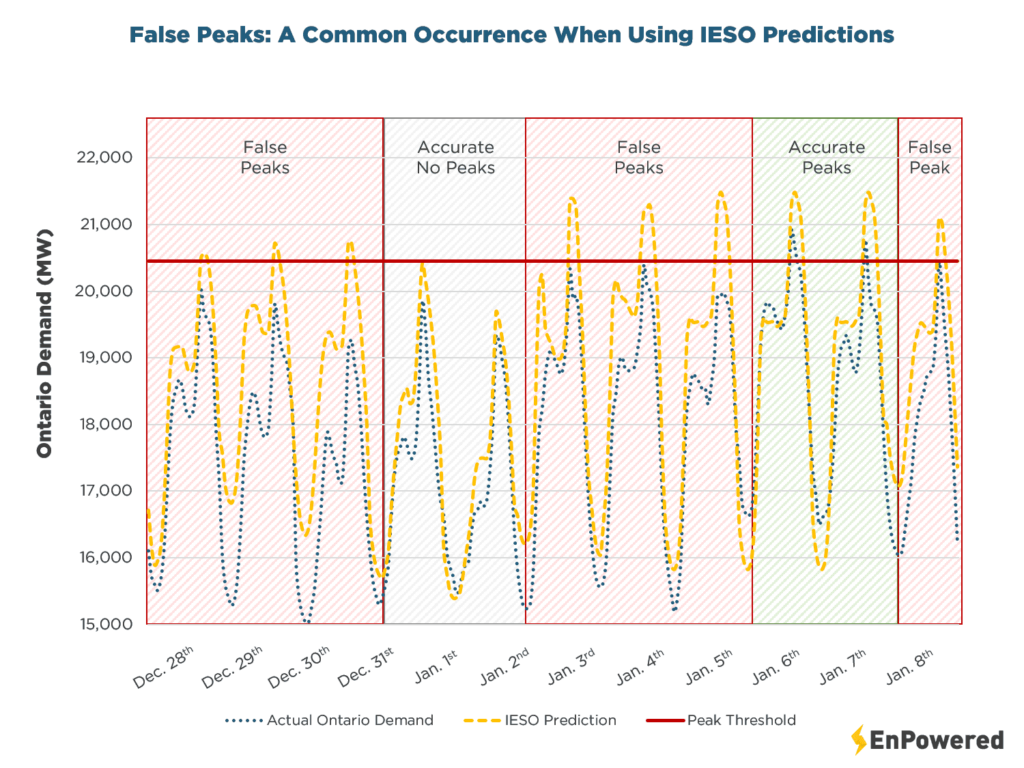
Peak Hour Precision
Rather than peak days, the true factor that matters is actually the top five peak hours each year. It is these specific peak hours which are used to calculate a Class A customer’s Global Adjustment costs each year.
Most Class A customers, in an attempt to catch this peak hour during a peak day, will reduce their electricity usage for periods of fives hours at a time. This is because they are not certain which exact hour will be the actual peak hour due to the inaccuracy of traditional predictive models.
With increased accuracy, however, a Class A business can focus their demand response efforts on a narrow window of time.
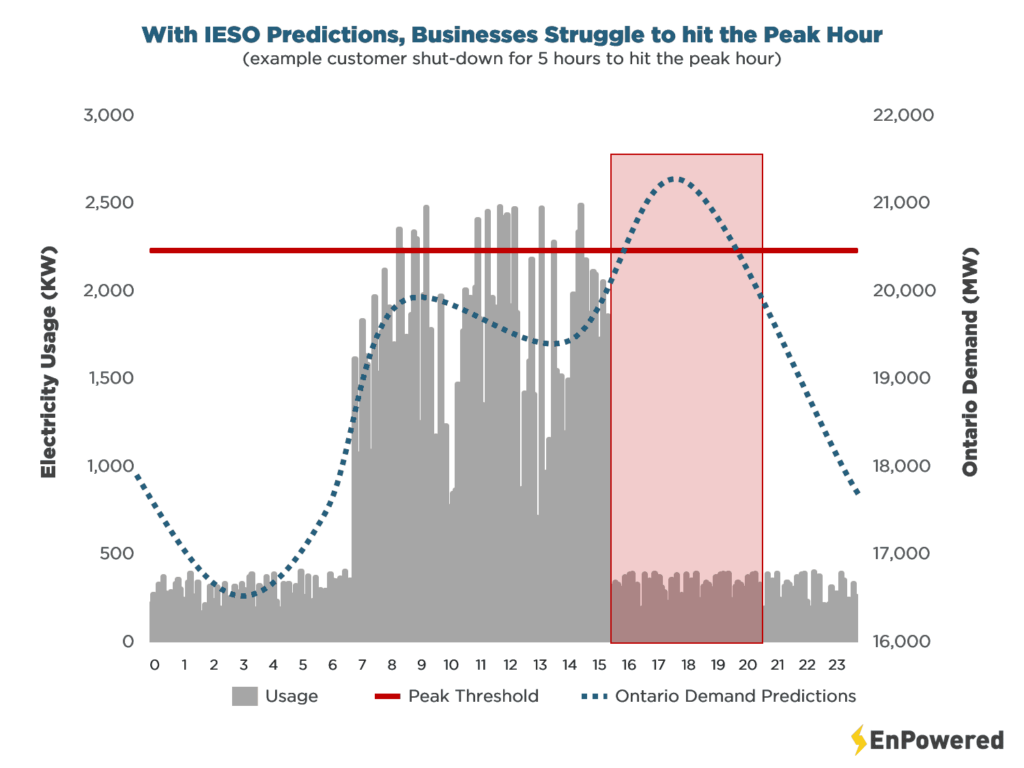
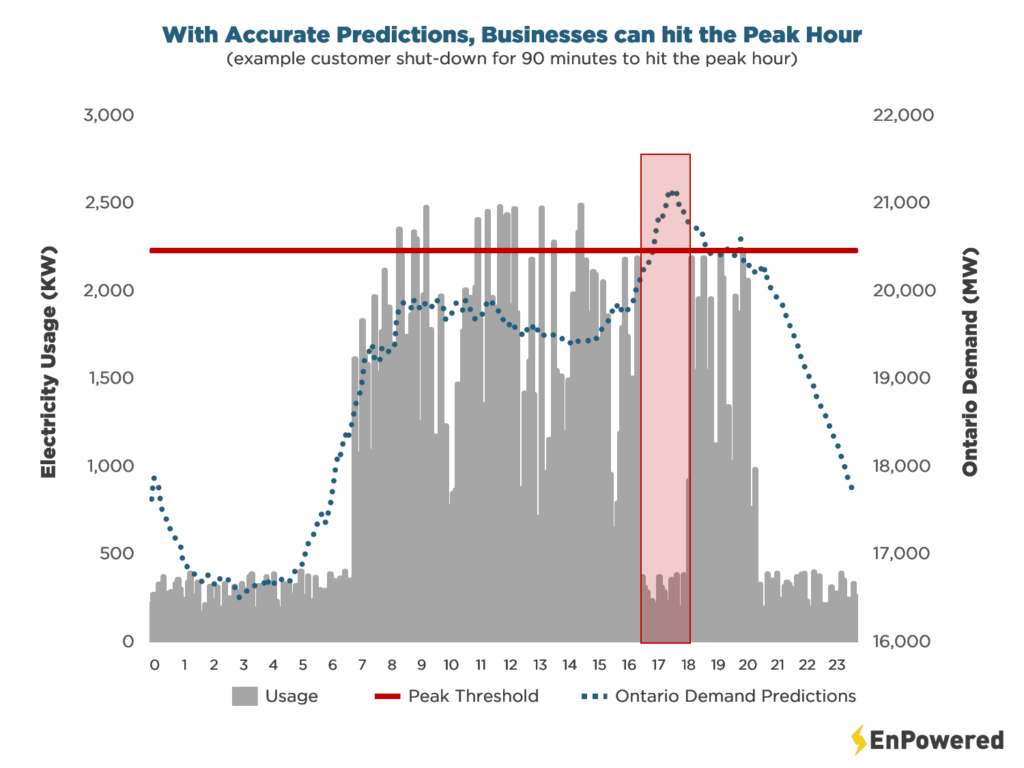
This enables them to increase their demand response efforts for the actual peak, thereby reducing the impact to production. In the 2017-2018 peak season, EnPowered predicted the actual peak hour with a high degree of accuracy.
On average, EnPowered’s customers avoid the peak hour while only having to reduce electricity usage for 1.5 hours, a significantly smaller window. With more accuracy in detecting the true peak hours, costly mistakes and perils like the “Double Peaks” described above, can be avoided.
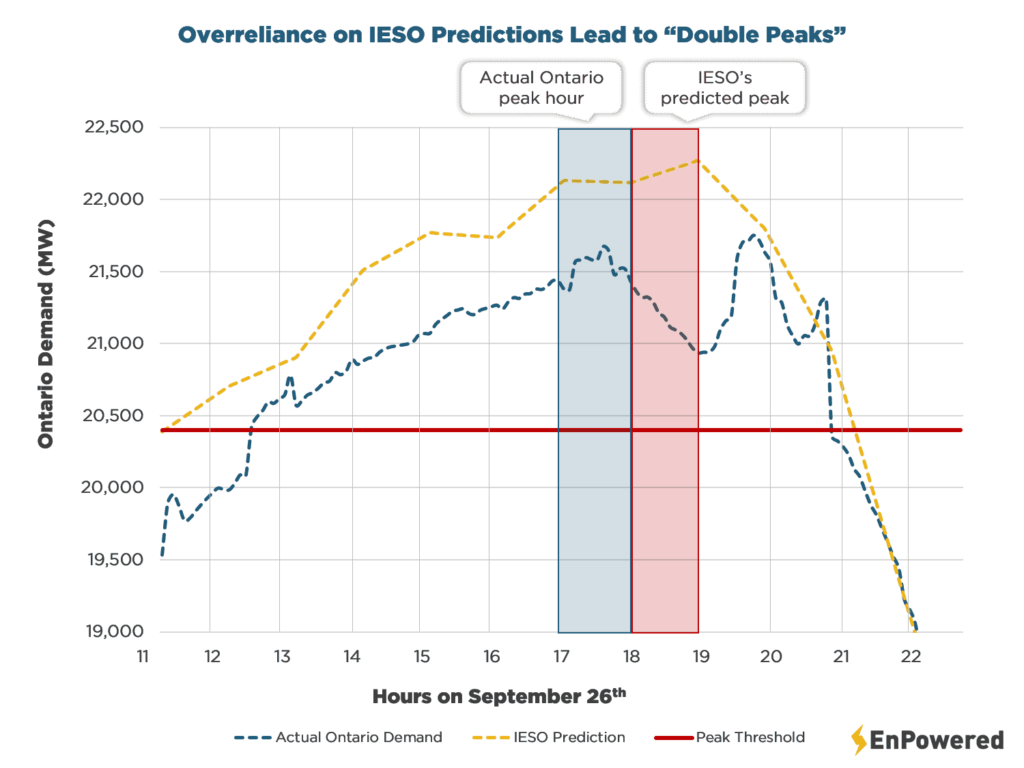
How to Beat the Market
Predicting the Ontario energy markets with this high degree of accuracy is not an easy task, as previously outlined in Section 4. The way EnPowered is able to deliver such accurate energy predictions is through through its proprietary and complex model that utilizes cutting-edge machine learning and artificial intelligence systems.
Rather than using linear regressions and manually analyzing the many important variables that influence energy demand in the Province, EnPowered’s prediction algorithms are able to find correlations between data sets and different variables that interact with one another in an active fashion.
This information is then processed and reviewed by additionally accounting for various variables and the relationships between them.
EnPowered’s forecasting model leverages an machine learning approach called a neural network, which allows for meta-pattern recognition. Where traditional forecasting falls short is when different variables themselves interact and influence one another.
This is not an issue for neural networks which excel at recognizing intra-variable relationships and do not run into the limitations that humans do when they analyze data. Specifically, for the EnPowered Ontario Demand Forecasting Model, the data that is used includes, but is not limited to, the following factors across all jurisdictions in Ontario updated and analyzed in real-time:
- Wind Data
- Snowfall Data
- Precipitation Data
- Node Data
- Usage Data
- Temperature Data
- Response Efforts
- Real-Time Usage Information
- Special Events, among others
In total, the model processes over four hundred million pieces of data which are updated on five-minute increments to perfect the model’s ability to detect patterns and trends in the Ontario energy market; a level of computation which is simply impossible with normal predictive modelling techniques.
Moreover, the model is constantly iterated and improved with new data and new algorithm adjustments for even greater efficiency and accuracy.
The result is that energy customers in Ontario receive highly accurate energy predictions that are updated every five minutes, 24/7. As such, the results of EnPowered’s model are extremely valuable to Class A customers as the predictions enable them to maximize savings in the ICI Program and minimize the impact to their production.
How a Class A Customer can Operate in the ICI Program
In summary, as a Global Adjustment Class A customer, there are four options available to save money in the ICI Program:
- Do-Nothing
- Public IESO Data
- EnPowered Predictions
- Hardware Solutions.
Do-Nothing
The Do-Nothing approach is the simplest option for a Class A customer.
A company can opt-in to the ICI Program without making any sort of adjustments to its energy usage. During the five peak periods that occur annually, a business can merely choose to continue using electricity in the same manner as it always has.
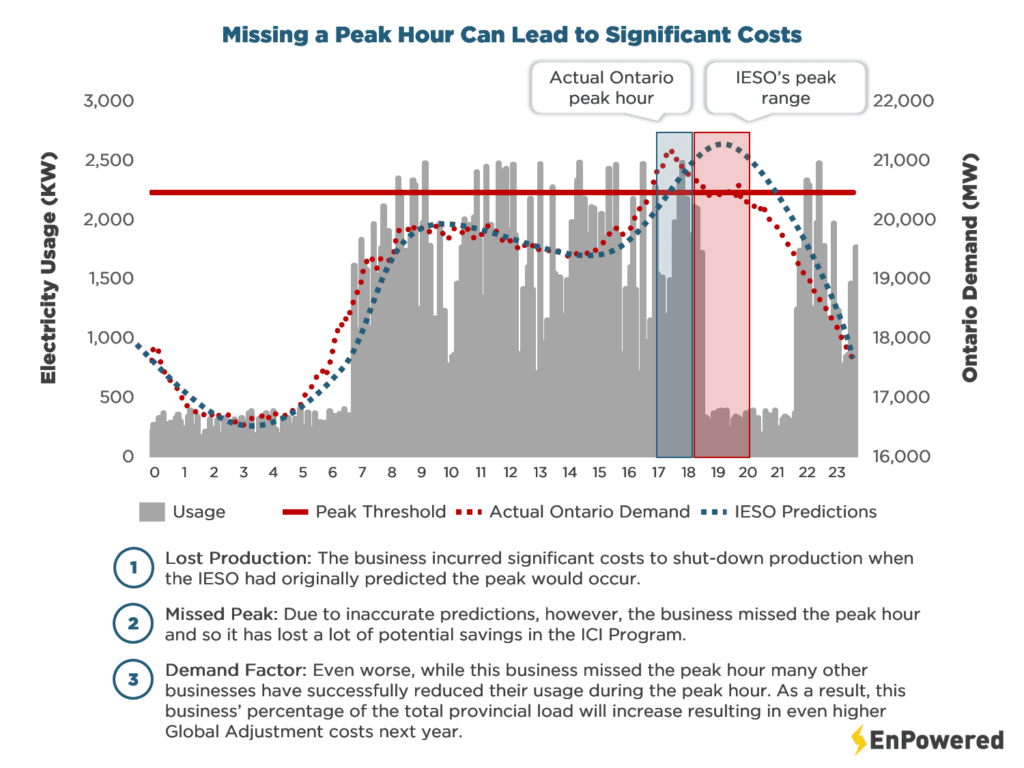
This could result in some minor savings, but it could also increase costs if the business uses too much electricity during the peak hours. In making the decision as to whether this option is one that makes sense, a decision-maker should look at its business’ energy usage and see how it compares to the total energy usage within the Province.
By calculating the business’ share of the total provincial energy demand, known as its Demand Factor, it would be able to understand its potential savings in the ICI Program, and also understand the risk and size of potential losses.
Public IESO Data
The next approach a company could pursue is to use publicly available IESO Data via the IESO Peak Tracker as the basis for its energy demand responses. This data is available for free, and most Class A businesses are currently using this public data, as are most of the energy consultants in the Ontario market.
Given that most consultants use the same information, it is better to analyze the public data directly, rather than hiring and paying an energy consultant to analyze the same data. This does require a significant amount of time from internal staff, however it may result in little or no savings when the public predictions are inaccurate for the reasons enumerated throughout this article and earlier in Section 4 of this series.
It is notable to mention that rather than searching for the IESO Peak Tracker daily, one can simply opt-in toour email notification service which sends the same IESO predictions to your email address whenever there is something that you need to be aware of.
EnPowered Predictions
A company could also avail of advanced EnPowered Predictions to accurately predict the exact peak hours without causing significant disruptions to their production schedules. By using EnPowered’s proprietary predictions predict, not only, the energy usage in the Province, but also predict how the rest of the market will respond, and provide predictions that are 50% more accurate than the IESO Peak Tracker.
With the industry’s most accurate predictions, EnPowered’s Class customers can catch all five peak hours each year, while only responding 10 times per year. In addition, when they respond, they only need to respond for 1 or 2 hours at a time instead of 5 hours.
The ICI Program for Class A customers is a great opportunity for businesses to reduce their Global Adjustment costs and save up to 70% on their electricity bills.
Combined, this means that EnPowered’s Class A customers greatly increase their savings in the ICI Program, and minimize the impact to their production. All of this is done with little investment of time or resources by the business itself.
Hardware Solutions
Finally, a company could invest resources into Hardware Solutions, purchasing hardware like batteries, co-generation units, or other systems that enable a company to reduce their electrical usage during peak hours. These solutions require a fairly significant investment of approximately $1-3M per MW that the business is looking to offset.
Although it may make sense for a business to install a storage system that is able to move an entire facility off-grid during peak hours, this is usually the most expensive option available. Instead, it usually makes more sense to first reduce electricity usage during peak hours by curtailing production, and then installing a storage system that offsets the remaining usage.
This option may not be available to every business, but it can help to reduce the investment in storage systems by over 50%. For example, a customer may use 4 MW of electricity on average, but may be able to curtail as much as 3 MW of usage during peak hours.
This then means that they would only need to install a 1 MW battery instead of a 4 MW battery, roughly $6M less in initial investment. This is why EnPowered always recommends that customers first attempt to curtail their usage during peak hours, before installing a storage system.
Most battery providers will attempt to install a storage system that runs the entire facility off-grid for 3-4 hours to enable the business catch the peak hours.
However, by using EnPowered’s market predictions, a business only has storage system for only 1.5 hours and still catch every peak hour due to the greater accuracy of EnPowered’s predictive model.
By using these market predictions, a business considering installing a storage system now only requires one that is 50-60% smaller in capacity while still retaining the same amount of savings each year. Combined, by following these practices, a business will be able to greatly reduce their initial investments and greatly increase their ROI.
Conclusion
The ICI Program for Class A customers is a great opportunity for businesses to reduce their Global Adjustment costs and save up to 70% on their electricity bills.
It is also a very complicated program to participate in and as more companies begin to participate in the Program, it is becoming increasingly difficult for businesses to maximize savings in the Program while minimizing production impacts.





